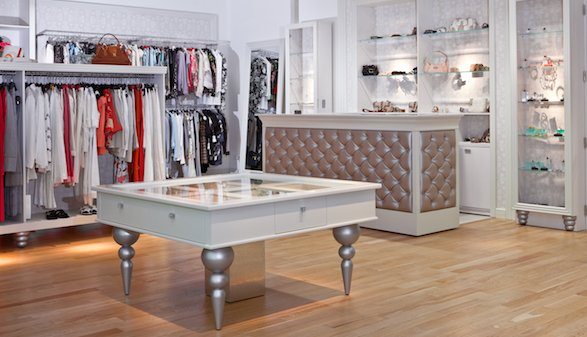Business
The Future of Selling Fashion
May 29, 2015

We love seeing all of the amazing news coming from the team at Conde Nast. They’re proving time and time again they are a modern publishing company able to create new, sustainable revenue streams that ultimately enhance relationships with their audience. Can’t wait to see their shopping experience come to life! –Sailthru
Think you know the latest trends in online retail? Check out this eTail research report we sponsored, which compiles survey data from hundreds of marketers on what channels create the highest ROI, what strategies to prioritize, the future of personalization, and more.
—
The recent news that media company Condé Nast – publisher of 140 or so glossy fashion and lifestyle magazines, including worldwide editions of Vogue and Vanity Fair – is putting its money behind a global e-commerce venture is proof, if ever it were needed, that the way fashion and lifestyle brands sell to the public has changed forever. In 2013, global e-commerce grew by 13%, a figure that was almost certainly equalled or surpassed in 2014, with increasing numbers of sellers, large and small, peddling their wares in the virtual marketplace.
The march of technology in our everyday lives has facilitated a revolution that has transformed consumer habits and the concept of shopping, faster than anyone could have predicted. It doesn’t seem that long ago that experienced retailers and fashion industry experts dismissed the notion of buying clothes online, commenting that luxury consumers wanted to touch and try their garments in a stylish boutique environment before parting with their cash.
Seeing Anna Wintour’s super stylish stable enter the online fashion marketplace to take on Natalie Massenet’s Net-A-Porter in a head to head battle will prove thrilling for consumers and industry watchers alike, as we see them slugging it out to see who can sell more Chloe, Marni, Kors and more, via their virtual shopping malls.
Were they wrong? No. There is a chunk of the world’s population that takes great pleasure in the retail experience, enjoying browsing in a bricks and mortar store and being served by a smiling – or sometimes, sadly, snarling – sales assistant.
And I believe that will always be the case. Whether you’re looking at mass-market or designer catwalk pieces, the idea that you can touch and feel something is very appealing. And the fact that shopping has become a leisure and social activity in itself, is enough to sustain the traditional shopfront in an evolved form for many years yet.
We will see an increased emphasis on the multi-sensory, experiential past-time of browsing and building brand loyalty in bricks and mortar stores, and less of a focus on actually selling from that space. I envisage retail architects will be briefed to deliver more creative environments where interactive experiences and relaxation infused with the brand’s style are part of the remit. It will be about a positive takeaway for the customer, rather than hard sell, and purchases will likely be a transaction via an in-store tablet or smartphone purchase for home delivery, something Angela Ahrendts visualised when building the new mothership for Burberry in London before moving on to her role at Apple in the USA.
Those who predicted fashion would never sell online have had to eat their words, after witnessing the phenomenal success not only of dedicated digital stores such as Net-A-Porter and Asos, but of the clever cross-pollination of e-tailing and traditional retailing to build staggering growth for visionary businesses such as Michael Kors, John Lewis and J Crew, for example.
As businesses, we need to offer virtual and real shopping environments to entice and engage the 21st century consumer, who might be equally happy spending online or in a high street store, or might be a devotee of one or the other.
What I think everyone in the world of selling consumer and luxury goods must recognize is that if we are to survive and thrive in the next decade and beyond we need to offer a completely seamless and impressive multi-platform experience for our customers, with personalised service at its heart. And that in itself has fundamentally changed the infrastructure of our industry.
While some brands have been cautious about online selling to customers – for example Chanel are only now dipping their highly-polished toes in the waters of virtual sales – they cannot afford to ignore the potential of the e-consumer any longer.
McKinsey reported that online luxury sales increased by 20 per cent in 2013, and estimate e-commerce sells will reach about US$21 billion by 2020, yet Bain suggest that around two fifths of brands still don’t sell online, direct to their customers.
I question whether retailers can continue the model of buying product wholesale from a supplier, managing the inventory from a multitude of brands and training their staff to sell them, when the manufacturers or brands have new channels to sell those very same products direct to consumers.
From a business perspective, selling online directly to customers is generally a time–efficient, functional operation that allows you to learn a lot about who is purchasing from you and their buying habits, which is valuable information. You know the demographics of your best customers, their average spend, frequency of buy, loyalty and much more. You know which images drive sales and which articles and avenues bring the customer to your website. All of this is important customer insight that can be utilized to streamline your operation, optimising stock ordering and minimising wastage, and ultimately managing considered growth, while offering consumers tailored service innovations and initiatives.
Having said this, far too many people invest in ‘buying customer addresses’ from other companies. I say good luck to you if you do this as it will bring you a bigger audience, but not necessarily the right people for your brand, even with the more sophisticated fine tuning available today, so your KPIs will be skewed, management decisions will inevitably be wrong and most importantly you are pushing your brand which can be very irritating to the end consumer. Focus should be to inspire the customers to pull.
In a retail shop, the above detailed customer information is currently much harder to gather, in fact virtually impossible unless you want to interview each store visitor at length. However, technology moves apace and we are currently witnessing the early stages of a revolution in analytical tools- e.g. anonymous facial recognition, mobile tracking etc. – to help understand in-store customer profiles, behaviour and data.
Many argue that bricks and mortar stores have customer service as an advantage over their online counterparts, but I firmly believe that virtual operations can offer superior levels of customer service on a far more consistent basis. There is very little human involvement, but what interaction there is can be focused on outstanding and personalised service. Online retailing is more about a system and protocols, and if those are managed well, the customer satisfaction is high.
The biggest issue a business has with online customer services is when you are selling to the global market and you have language issues and distribution issues. You need to consider the 24hr operation: that someone is shopping on your site somewhere in the world at all hours of the day, and that they may need an online chat facility or a friendly service agent at the end of a phone, speaking their language.
When it comes to staff, there is a much lower turnover rate in customer services than in retail, which has a very high rate of about 30-40 per cent, plus a lot of part-time workers. As rents continue to rise, retailers tend to reduce staff pay or staff numbers to cut costs, so this perpetuates the challenges of delivering consistent, high quality in-store customer service.
One of the interesting things to me, is how many larger operations are struggling to streamline their enterprise across both a retail and e-tail platform, which often end up competing internally for sales figures rather than working hand-in-hand for the good of the customer, and ultimately then, for the good of the business.
Over the next decade or so, as a result of these shifting business models and the increasing ability to engage directly with customers, I envisage substantial change in the wholesale sector.
Wholesale brands need to be in department stores, such as SAKS, or Barneys, or Lane Crawford or Selfridges or in an online department store such as Net-A-Porter or the new Condé Nast venture or indeed in an independent boutique, such as Browns or Matches, to get the right footfall – real or virtual – to reach their target customer.
However, in brand valuations, the investment world considers revenue and profit from wholesale accounts to be very vulnerable, as there is no guarantee of longevity. As a wholesale brand, you need to double your prices to be able to share your margin with the retailer, and you’re giving away all your valuable sales data, which the store can utilise to their end, developing their own-label collections in-house to extend their own margins. It makes sense to me that businesses such as Matches, John Lewis, Net-A-Porter and ASOS have all created their own ranges, based on their in-depth knowledge of what their customers are buying, and with a view to increasing profits. Increasingly, these own-label collections can be given prominent store space as they are the most lucrative pieces on the shop floor, so sales of bought-in brands will suffer.
I think we are going to see a steady streamlining of brands and their operations: wholesaling will fall by the wayside, and they will focus on selling direct to their customers to maintain their margins. Start-up enterprises will not use the wholesale model but will focus growth on direct customer relationships, as I have in my own fashion label, Winser London.
As a privately-owned start-up, this model has allowed me to utilize one of the most efficient growth mechanisms for my business: client recommendation. My loyal customers bring their friends to our events, invite their friends and their networks to shop online, spread the word via the world of social media, all which has proved to be the most cost-effective ways to gain new custom, with targeted, cost-effective marketing that delivers tangible results. It’s a concept that gives labels potential to grow in a controlled way, without the risks of wholesaling, all the while building relationships with consumers and learning about their needs and desires – the most valuable insight a business can own. The global reach of the web and ever-more efficient distribution networks, allows a substantial and constantly growing choice of brands, yet the consumer still responds well to personalised conversation, building loyalty with targeted retention and reward schemes, even if that relationship crosses continents.
The exponential growth of Net-A-Porter and other online multi-brand boutiques, based on the online wholesale model, is now giving way to a phase of mergers and acquisitions, as the space gets squashed by online own-brand website growth. The grande dame of independent boutiques, Joan Burstein, has just sold her London store, Browns, to online boutique marketplace, Farfetch, in a move that is sure to be mirrored with other acquisitions thanks to a recent chunk of investment capital in the operation.
These enterprises are also – through necessity – engaging in more personal interaction with customers via glossy editorial-style shoppable magazines and social networks, such as the innovative newly-launched Net-A-Porter’s Net Set app, the world’s first luxury invitation-only shoppable mobile social network designed to build loyal networks of customers sharing their material aspirations and purchases.
So, as the traditional wholesale model dwindles, we are looking at a fascinating re-modelling of the fashion and luxury marketplace over the coming years. Bricks and mortar stores will be repurposed as experiential marketing tools to offer immersive brand DNA environments and the opportunity to touch and feel. Own-brand virtual stores will be the area where we will witness tangible growth in sales figures and improved margins, as a focus on efficient distribution delivers strong, consistent customer service for consumers. But the real success stories will come where these two platforms work cohesively to offer a truly 360 degree omnichannel brand experience which is more innovative, intriguing and personalised for consumers.
This article was written by Kim Winser from Forbes and was legally licensed through the NewsCred publisher network.
The State of Brand Loyalty in the U.S. in 2023
Related



